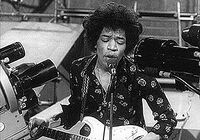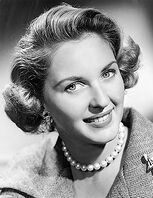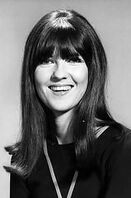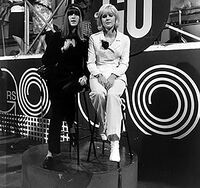Ready Steady Go!
| Ready Steady Go! | |
|---|---|
 | |
| Genre | Music |
| Presented by |
|
| Country of origin | Gylias |
| Original language(s) | |
| No. of episodes | 400 |
| Release | |
| Original network | GTV2 |
| Original release | 10 May 1963 – 1 January 1971 |
Ready Steady Go! (abbreviated RSG!) is a Gylian popular music programme. It originally aired on Fridays from 10 May 1963 to 1 January 1971, on GTV2.
Presented by Cathy French and Cathy McGowan, RSG! was famed for its anarchic atmosphere, and became Gylias' premier pop music programme. It was a pioneer in the presentation of pop music on television, and played a significant role in the Gylian Invasion.
History
The idea for the programme came from Estelle Parker and Cecilia Parker, the joint Head of Programming of GTV. After the creation of GTV2, the sisters pushed for the creation of a pop music programme that would appeal to a young audience. It was conceived as a no-frills production, to avoid anything distracting from the music.
Ready Steady Go! began airing on 10 May 1963. It quickly became a hit, and served as the main national outlet for popular music. It reflected many of the developments of the period, from Beatiemania to Groovy Gylias and the "psychedelic revolution".
It gave several acts their breakthrough to national popularity, including The Watts, The Byrds, France Gall, The Dandys, The Tea Set, The Sapphires, and The Jimi Hendrix Experience.
GTV licensed the show for broadcast abroad, helping position it at the vanguard of the Gylian Invasion. Groundbreaking in the presentation of pop music on television, it resulted in several foreign versions, although these often adopted a more conventional presentation.
The programme ended on 1 January 1971, because presenter Cathy McGowan wished to move on to other projects. She was convinced to remain until the 400th episode, which became the finale.
The show's episodes were made available on Proton in the 1990s.
Production

Ready Steady Go! was filmed in a small studio in Mişeyáke, which ensured the premises were frequently crowded. Set design was minimal: studio walls were covered with posters, and some notice boards were placed in the studio rear, which the audience took advantage of.
The entire studio was used. Bands appeared performing on different mini-stages, studio gantries, or staircases. Solo artists performed on the main floor, very close to the audience and cameras. Acts performed live, and the show often substituted the audio for the studio recordings of the respective songs.
The audience was featured as dancers, and the interaction between audience and artists was emphasised. The audience was chosen through a mixture of open entry and invitation. The crew would invite talented and fashionably-dressed dancers from local clubs. Other audience members would travel to Mişeyáke from other cities to attend taping. This ensured a hip audience on the same wavelength as featured artists.
The show aired on Fridays, which inspired its famous catchphrase "The weekend starts here!". The title sequence consisted of an aerial shot of the studio and audience, already in progress, with the Ready Steady Go! logo superimposed. There was no set theme song. Often, featured bands would improvise jingles based on their songs, a practice borrowed from Gylian Radio.
Especially for foreign viewers, RSG! was a famous example of GNBS' "enthusiastic amateurism". The cameras could not be hidden in the compact studio, and instead were made part of the scenery or the action.
The show had no director, and the crew largely performed editing on the fly. Isabel Longstowe memorably likened the show to "an anarchic party where the performers happened to drop by".
Presenters
Ready Steady Go! was presented by "the two Cathys" — Cathy French and Cathy McGowan. The two had very different backgrounds and styles.
Cathy French was a veteran broadcaster of aristocratic descent who had begun her career on radio in the Free Territories, and was praised by Estelle Parker as "marvellously unflappable".
Cathy McGowan was the same age as the show's audience, and had never presented a show before. Her stumbling over lines, flubbed introductions, and losing her cool made her more popular, reinforcing her image as an average teenager.
While Cathy French was multilingual — and often conducted the interviews with Francophone guests due to her fluency —, Cathy McGowan spoke English with a thick Schottian accent and "a ceaseless barrage of teenage slang" that baffled some viewers almost as much as her accent. She almost invariably praised things as "fab" or "smashing", and criticised things as "square" or "out".
The presenters were integral to the show's success. They formed a dynamic similar to "a hip aunt and her cool niece", with Cathy French's poise and elegance complementing Cathy McGowan's enthusiastic fan. Many viewers watched RSG! as much for the Cathys' interplay as for the music itself. For many, Cathy French represented a sympathetic and contemporary adult figure, a role that resonated with the Golden Revolution. Her unflappable demeanour and ability to keep up with the programme's goings-on made her an iconic television personality.
The Cathys conducted off-the-cuff interviews with guests between performances, and helped realise the show's anything-goes atmosphere. Cathy McGowan in particular joined the fun and games, miming along as guests performed, or chatting with audience members, while Cathy French occasionally danced to the music being performed. Guest acts would dance among the audience when not performing themselves.
Musical guests
Ready Steady Go! featured most successful artists of the era, including The Beaties, The Watts, The Dandys, The Byrds, France Gall, Marian Ellis, The Sapphires, The Sunliners, The Monkees, The Creation, The Move, The Tea Set, The Jimi Hendrix Experience, Desert Sands, Deep Horizon, Sister Duyen, and Thaïs Delaplace.
Guest selection was eclectic, encompassing successful acts, up-and-coming acts, and acts outside of its usual pop/rock milieu. Its practices were shaped by GNBS' spin quotas, and Cathy French recalled that the show "took its mission of exposing the nation to new music extremely seriously".
Several acts broke through to national popularity as a result of RSG!. The most famous case was arguably The Watts, whose first appearance performing "I Can't Explain" in 1965 catapulted them to fame. The Watts made the most appearances of any artist, totalling 36. Some of their early appearances were made official music videos for their respective songs.
For many foreign acts, RSG! was their first appearance on Gylian television.
Legacy
Ready Steady Go! was a major hit during its lifetime, and had a significant influence at home and abroad. It was innovative in the presentation of pop music on television, establishing the anarchic and audience-focused format that became the norm for Gylian music shows.
After its cancellation, several other shows appeared in its wake, of which The Week in Music is considered its successor spiritually as well as in impact.
RSG! both reflected and influenced Gylian society and culture at the time of the Golden Revolution, Groovy Gylias, and "psychedelic revolution". Its free-for-all character became iconic, a feature foreign versions tended to avoid or downplay. Music journalist Mana Kirishima praised the show for "making pop music work on a truly national scale … one could almost feel a tremor of excitement sweeping from Şet to Velouria".
By following GNBS policies regarding spin quotas and regional representation, the programme took a notable unifying role, bringing together Gylias' multiple music scenes and subcultures onto the federal stage. Tomoko Tōsaka referred to its "public service" by "bringing the Golden Revolution to every living room".
RSG! has been often parodied and referenced in Gylian pop culture. The video for Stella Star's "Nata di Marzo" shows the band performing on Ready Steady Go!.


